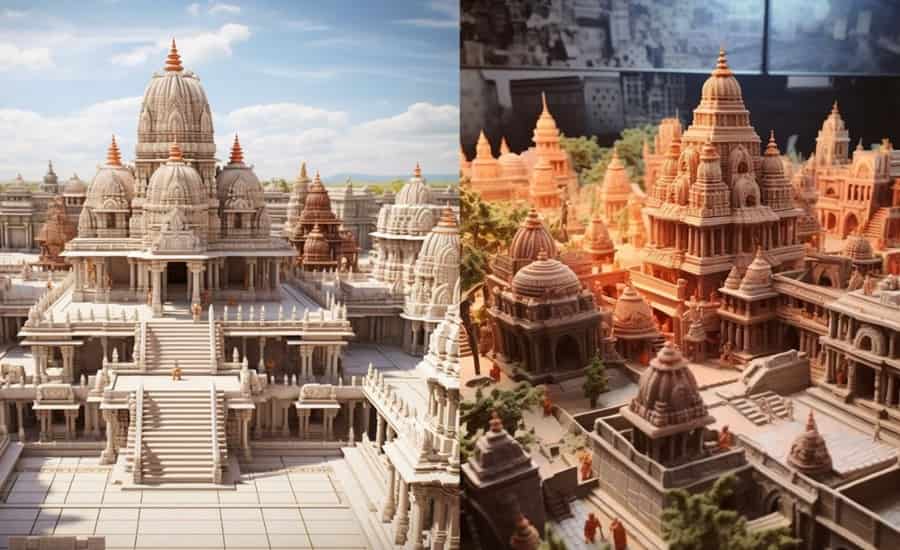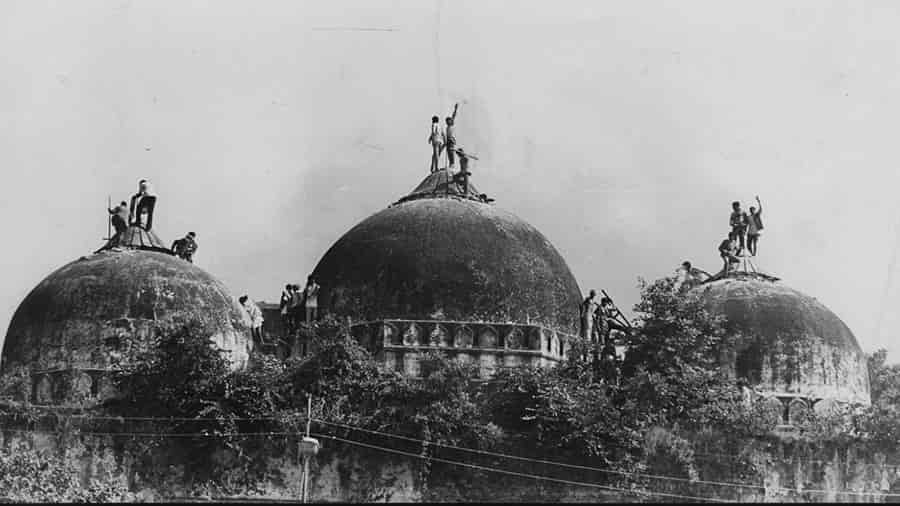The history of the Shri Ram Mandir in Ayodhya is deeply rooted in Hindu mythology and legends, tracing its origins to ancient times. The story of the temple revolves around the revered figure of Lord Rama, a significant deity in Hinduism, and the epic tale of the Ramayana. This narrative, rich with mythological elements and cultural significance, has played a pivotal role in shaping the beliefs and sentiments of millions of Hindus over the centuries.

- Mythological Foundations
- Ayodhya as the Sacred Abode
- The Janmabhoomi and the Babri Mosque
- Historical Perspectives
- Modern Ram Janmabhoomi Movement
- The Demolition of the Babri Mosque
- Legal Battles and Supreme Court Verdict
- Formation of the Shri Ram Janmabhoomi Teerth Kshetra
- Commencement of Temple Construction
- Scheduled Installation of Lord Ram Idol
- Bhoomi Poojan Ceremony
- Reactions to the Construction
- Recent Developments and Future Plans
- Consecration and Ramotsav
- Donations and Fundraising
- Archaeological Survey of India – Evidences
- Conclusion
Mythological Foundations
The Shri Ram Mandir finds its mythical roots in the Ramayana, an ancient Hindu epic attributed to the sage Valmiki. The Ramayana narrates the life and adventures of Lord Rama, the seventh avatar of Lord Vishnu. According to Hindu mythology, Lord Rama was born in Ayodhya to King Dasharatha and Queen Kaushalya.
The epic begins with the divine birth of Rama and his three brothers, Bharata, Lakshmana, and Shatrughna. The early years of Rama’s life are marked by his marriage to Sita, an incarnation of the goddess Lakshmi. However, Rama’s exile to the forest, prompted by the schemes of his stepmother Kaikeyi, sets in motion a series of events leading to the legendary battle against the demon king Ravana.
The central episode of the Ramayana, known as the “Ramayana Yuddha” or the Battle of Lanka, culminates in Rama’s victory over Ravana and the rescue of Sita. After the triumphant return to Ayodhya, Rama is crowned as the king, marking the beginning of the ideal rule known as “Ram Rajya.” The narrative of the Ramayana encapsulates themes of duty, righteousness, and the victory of good over evil.
Ayodhya as the Sacred Abode
Ayodhya, the birthplace of Lord Rama, holds profound significance in Hindu tradition. The city is depicted as a symbol of dharma (righteousness) and the epitome of an ideal kingdom. The belief that Ayodhya is the divine abode of Lord Rama has been passed down through generations, fostering a deep emotional and spiritual connection for Hindus.
The Ramayana describes Ayodhya as a magnificent city adorned with grand palaces, lush gardens, and noble citizens. The narrative paints a vivid picture of the utopian society under Rama’s rule, emphasizing principles of justice, virtue, and compassion. The association of Ayodhya with Lord Rama’s birth transforms the city into a sacred pilgrimage site for devotees seeking to connect with the divine.
The Janmabhoomi and the Babri Mosque
The term “Janmabhoomi” translates to “birthplace” in Sanskrit, and Ayodhya’s Janmabhoomi holds a central place in the Ramayana’s narrative. Tradition identifies the exact spot in Ayodhya where Rama is believed to have been born as the sacred Janmabhoomi. Devotees consider this location to be particularly auspicious, and it became the focal point of a significant historical and religious controversy in later centuries.
The controversy revolves around the construction of the Babri Mosque in Ayodhya during the Mughal period. According to historical accounts, the mosque was built in the 16th century by Mir Baqi, a commander of the Mughal emperor Babur. Local Hindu belief, rooted in the Ramayana, asserts that the mosque was constructed on the very spot regarded as the birthplace of Lord Rama.
The conflicting claims over the Janmabhoomi gave rise to tensions and disputes that persisted over the centuries. The mosque stood as a symbol of religious and cultural coexistence but also became a source of contention, especially in the modern era.
Historical Perspectives
Historical records and accounts from travelers and scholars provide glimpses into the evolving narrative surrounding the Janmabhoomi in Ayodhya. English traveler William Finch, during his visit to Ayodhya in 1611, recorded ruins but made no mention of a mosque. In the 17th century, the appearance of a mosque at the site is suggested by accounts like Lal Das’s Awadh-Vilasa.
The Jesuit missionary Joseph Tiefenthaler, visiting Ayodhya in the 18th century, wrote about the demolition of a fortress associated with Lord Rama and the construction of a mosque in its place. Subsequent visitors, including Francis Buchanan in 1810, noted the existence of a temple dedicated to Rama that was replaced by the mosque.
Controversy surrounds the authenticity of inscriptions on the Babri Mosque, with claims that they were added much later, raising questions about the mosque’s actual historical connection to Babur’s era. The debate over the historical veracity of these claims adds complexity to the Janmabhoomi saga.
Modern Ram Janmabhoomi Movement
The 20th century witnessed the intensification of the Ram Janmabhoomi movement, spearheaded by various Hindu organizations. The Vishwa Hindu Parishad (VHP), a part of the broader Hindu nationalist family Sangh Parivar, played a key role in mobilizing support for the construction of a grand temple at the Janmabhoomi site.
In the 1980s, the movement gained momentum as the VHP and other affiliated organizations rallied for the reclamation of the Janmabhoomi and the construction of a Ram temple. The rallying cry of “Jai Shree Ram” echoed across the country, and devotees contributed funds and bricks inscribed with the slogan.
The Demolition of the Babri Mosque

The culmination of the Ram Janmabhoomi movement came on December 6, 1992, when a large gathering of kar sevaks (volunteers) organized by the VHP and the Bharatiya Janata Party (BJP) converged at the disputed site in Ayodhya. The situation escalated, leading to the violent demolition of the Babri Mosque.
The demolition of the mosque had far-reaching consequences, sparking inter-communal riots and tensions between India’s Hindu and Muslim communities. The incident also had repercussions beyond India’s borders, with reports of attacks on Hindu temples in Pakistan and Bangladesh.
Legal Battles and Supreme Court Verdict
In the aftermath of the Babri Mosque demolition, legal battles ensued over the ownership and status of the disputed site. Various title disputes and legal proceedings unfolded, with multiple parties staking claims to the land.
The case reached its pinnacle with the Supreme Court of India delivering a landmark verdict on November 9, 2019. The court ruled in favor of the construction of a Ram temple at the Janmabhoomi site, while also directing the allocation of a separate piece of land in Ayodhya for the construction of a mosque.
Formation of the Shri Ram Janmabhoomi Teerth Kshetra
Following the Supreme Court verdict, the Indian government formed the Shri Ram Janmabhoomi Teerth Kshetra, a trust entrusted with overseeing the construction of the Ram temple. The trust, consisting of prominent members, was given the responsibility of fundraising, planning, and executing the construction.
Commencement of Temple Construction
The construction of the Ram temple officially commenced in March 2020, with the foundation stone-laying ceremony conducted by Prime Minister Narendra Modi on August 5, 2020. The event marked a significant moment in the cultural and religious history of Ayodhya and India as a whole.
The construction process faced temporary suspensions, including one due to the COVID-19 pandemic. However, the project persevered, and by May 2023, substantial progress had been made, with 70% of the groundwork and 40% of the roof work completed.
Scheduled Installation of Lord Ram Idol
The consecration ceremony for the installation of the Lord Ram idol in the garbhagriha is scheduled for January 22, 2024. Champat Rai, the General Secretary of the Shri Ram Janmbhoomi Teerth Kshetra Trust, will lead the ceremony. Prime Minister Narendra Modi received a formal invitation to attend the auspicious event.
Bhoomi Poojan Ceremony
The official commencement of temple construction occurred after the Bhoomi Poojan ceremony on August 5, 2020. The ceremony included Vedic rituals, culminating in the installation of a 40 kg silver brick as the foundation stone by Prime Minister Narendra Modi. The event was preceded by a three-day series of religious rituals and prayers.
Reactions to the Construction
The construction of the Ram temple has elicited varied reactions from different quarters. Some priests and religious leaders expressed concerns about deviations from proper ritual procedures during the ceremonies. Criticism also arose regarding the chosen date of August 5, which marked one year since the revocation of the special status of Jammu and Kashmir.
Pakistan officially criticized India for commencing the construction, citing historical disputes over the site. Meanwhile, various Indian political leaders praised the ground-breaking ceremony, highlighting its cultural and religious significance.
Recent Developments and Future Plans
In August 2021, a public viewing location was established to allow people to witness the construction. The removal of debris and the foundation work continued, with 47-48 layers of roller-compacted concrete completed by mid-September 2021.
In January 2023, two Shaligram rocks, estimated to be 60 million years old and weighing 26 and 14 tonnes, were sent from the Gandaki River in Nepal. These rocks were used in carving the idol of Ram Lalla in the sanctum sanctorum. As of May 2023, the Shri Ram Janmabhoomi Teerth Kshetra Trust reported that 70% of the groundwork and 40% of the roof work had been completed.
Consecration and Ramotsav
Preparations for the pran pratishtha (consecration) ceremony have been underway, with the Uttar Pradesh government allocating ₹100 crore for ‘Ramotsav,’ a series of religious events across 826 local bodies. The events commenced in December 2023 and will culminate in grand celebrations from Makar Sankranti on January 14/15 until the inauguration of the Ram temple on January 22.
Prime Minister Narendra Modi, along with other political leaders and dignitaries, has been invited for the consecration ceremony. The guest list includes industrialists, scientists, actors, army officers, spiritual leaders, and awardees.
Donations and Fundraising
The temple trust initiated a nationwide “mass contact and contribution campaign” to reach 550-600 million people. Voluntary donations of ₹10 and higher were accepted. President of India Ram Nath Kovind made the first contribution of ₹501,000 in January 2021. By April 2021, around ₹5,000 crore was collected from donations across India. Notably, the campaign received contributions from members of the Muslim and Christian communities.
Criticism arose regarding the collection of funds, with some political figures questioning the transparency of the process. Allegations of corruption led to the involvement of Tata Consultancy Services to digitize the accounts.
Archaeological Survey of India – Evidences
The Archaeological Survey of India (ASI) conducted two significant excavations, the first in 1978–79 and the second in 2003, to study the site’s archaeological evidence.
During the first excavation, led by B. B. Lal, the team discovered 12 pillars of the mosque made from the remains of a Hindu temple. The pillars had Purna Kalasha symbols, indicating prosperity, found in temples of the 12th and 13th centuries. Terracotta sculptures depicting human beings and animals were also unearthed, consistent with a temple’s characteristics.
In the 2003 excavation, over 50 pillars were found, reinforcing the belief that a Hindu temple stood beneath the mosque. The excavators discovered a temple system, ‘pranali,’ ‘shikhara,’ and other architectural elements. Terracotta remains, including 263 pieces depicting gods, goddesses, and human figures, provided further evidence of a temple.
An inscription of ‘Vishnu Hari Shila Phalak’ was found on two remains at the site, supporting the existence of a Hindu temple.
Conclusion
The history of the Shri Ram Mandir in Ayodhya is a tapestry woven with threads of mythology, legends, historical events, and contemporary socio-political movements. Its significance transcends religious boundaries, encapsulating the cultural and emotional ethos of millions of people. The construction of the Ram temple represents not only a physical structure but also a manifestation of faith, resilience, and the enduring legacy of the epic tale of Lord Rama. As the consecration ceremony approaches, it marks a defining moment in India’s cultural landscape, reinforcing the deep-rooted connection between mythology, history, and the collective consciousness of its people.
